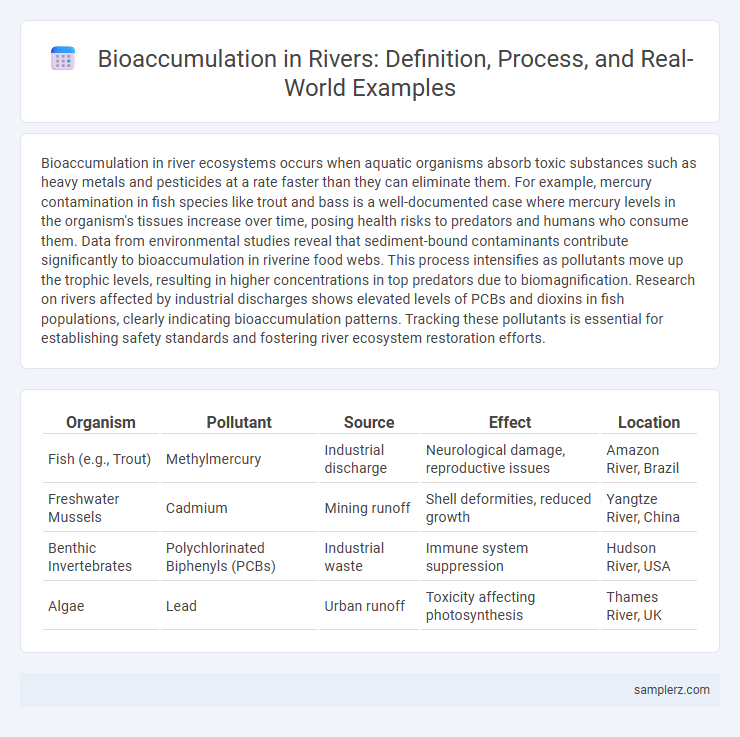Bioaccumulation in river ecosystems occurs when aquatic organisms absorb toxic substances such as heavy metals and pesticides at a rate faster than they can eliminate them. For example, mercury contamination in fish species like trout and bass is a well-documented case where mercury levels in the organism's tissues increase over time, posing health risks to predators and humans who consume them. Data from environmental studies reveal that sediment-bound contaminants contribute significantly to bioaccumulation in riverine food webs. This process intensifies as pollutants move up the trophic levels, resulting in higher concentrations in top predators due to biomagnification. Research on rivers affected by industrial discharges shows elevated levels of PCBs and dioxins in fish populations, clearly indicating bioaccumulation patterns. Tracking these pollutants is essential for establishing safety standards and fostering river ecosystem restoration efforts.
Table of Comparison
| Organism | Pollutant | Source | Effect | Location |
|---|---|---|---|---|
| Fish (e.g., Trout) | Methylmercury | Industrial discharge | Neurological damage, reproductive issues | Amazon River, Brazil |
| Freshwater Mussels | Cadmium | Mining runoff | Shell deformities, reduced growth | Yangtze River, China |
| Benthic Invertebrates | Polychlorinated Biphenyls (PCBs) | Industrial waste | Immune system suppression | Hudson River, USA |
| Algae | Lead | Urban runoff | Toxicity affecting photosynthesis | Thames River, UK |
Introduction to Bioaccumulation in River Ecosystems
Bioaccumulation in river ecosystems occurs when pollutants such as mercury and polychlorinated biphenyls (PCBs) concentrate in aquatic organisms like fish and invertebrates over time. These toxic substances accumulate primarily through contaminated water and sediment, increasing in concentration higher up the food chain. Monitoring bioaccumulation in river environments is crucial for assessing ecosystem health and protecting wildlife as well as human populations relying on these water resources.
How Bioaccumulation Occurs in Aquatic Environments
Bioaccumulation in aquatic environments occurs when contaminants like heavy metals and pesticides accumulate in river organisms such as algae, small fish, and invertebrates through direct absorption or consumption of contaminated food. These toxic substances persist in tissues because they are not easily broken down or excreted, leading to higher concentrations at each successive trophic level. Over time, predator species, including larger fish and birds, exhibit elevated contaminant loads that can disrupt ecosystems and pose health risks to humans consuming fish from affected rivers.
Mercury Accumulation in River Fish
Mercury accumulation in river fish occurs when inorganic mercury from industrial discharge converts into toxic methylmercury by microbial activity in sediments, which then bioaccumulates through the aquatic food web. Predatory fish such as bass and pike show higher mercury concentrations due to biomagnification, posing significant health risks to wildlife and humans consuming contaminated fish. Monitoring mercury levels in river ecosystems is crucial for assessing environmental pollution and implementing effective pollution control measures.
Persistent Organic Pollutants and River Bioaccumulation
Persistent Organic Pollutants (POPs) such as polychlorinated biphenyls (PCBs) and DDT accumulate in river ecosystems through bioaccumulation, concentrating in the fatty tissues of aquatic organisms. These chemicals resist degradation, leading to higher concentrations in predator species over time, which disrupts aquatic food webs and poses risks to biodiversity and human health. Monitoring POP levels in fish and sediment reveals the extent of contamination and informs river management practices aimed at reducing pollutant inputs and ecological impacts.
Case Study: PCB Contamination in River Food Chains
Polychlorinated biphenyls (PCBs) have been detected at elevated levels in river sediments, leading to significant bioaccumulation in aquatic organisms such as fish and invertebrates. These persistent organic pollutants biomagnify through the river food chain, resulting in toxic concentrations in top predators like large fish and birds, impacting their health and reproduction. Monitoring data from the Hudson River exemplifies how PCB contamination disrupts aquatic ecosystems and poses long-term ecological risks.
Effects of Bioaccumulation on River Biodiversity
Bioaccumulation of heavy metals such as mercury and lead in river ecosystems leads to toxic concentrations in aquatic organisms, disrupting food webs and reducing species diversity. Predatory fish accumulate these toxins through the consumption of contaminated prey, resulting in reproductive failures and population declines. This cascade effect alters river biodiversity by diminishing sensitive species and allowing tolerant organisms to dominate, ultimately compromising ecosystem stability and function.
Heavy Metals in River Sediments and Aquatic Life
Heavy metals such as mercury, lead, and cadmium accumulate in river sediments, posing toxic risks to aquatic ecosystems. These contaminants bioaccumulate in fish and invertebrates, magnifying through the food chain and threatening biodiversity. Monitoring sediment heavy metal concentrations is crucial to assess pollution levels and implement effective river management strategies.
Human Health Risks from River Bioaccumulation
Heavy metals like mercury and lead accumulate in river sediments and aquatic organisms through bioaccumulation, posing significant human health risks when contaminated fish are consumed. Persistent organic pollutants such as polychlorinated biphenyls (PCBs) also bioaccumulate in river ecosystems, leading to toxic effects including neurological damage and increased cancer risk in humans. Continuous exposure to these bioaccumulated contaminants through the food chain highlights the urgent need for monitoring and regulating river water quality to protect public health.
Mitigation Strategies for River Bioaccumulation
Mitigation strategies for river bioaccumulation focus on reducing pollutant discharge through enhanced wastewater treatment and strict regulation of industrial effluents containing heavy metals and persistent organic pollutants. Restoration of riparian vegetation and wetland buffers helps to trap and degrade contaminants before they enter aquatic ecosystems. Continuous monitoring programs coupled with public awareness campaigns are crucial to identify pollution sources and promote environmentally responsible practices among communities.
Monitoring and Assessment of Bioaccumulative Substances in Rivers
Monitoring bioaccumulative substances in rivers involves regular sampling and analysis of water, sediment, and biota to detect contaminants like mercury, polychlorinated biphenyls (PCBs), and pesticides that accumulate in aquatic organisms. Advanced techniques such as biomonitoring using indicator species, coupled with chemical analysis and GIS mapping, provide detailed assessments of spatial and temporal trends in contaminant levels. Effective monitoring programs support risk assessment and management strategies to protect river ecosystems and public health from the adverse effects of bioaccumulation.

example of bioaccumulation in river Infographic
 samplerz.com
samplerz.com